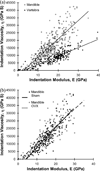Effect of estrogen deficiency on regional variation of a viscoelastic tissue property of bone
- PMID: 23141522
- PMCID: PMC3529751
- DOI: 10.1016/j.jbiomech.2012.10.013
Effect of estrogen deficiency on regional variation of a viscoelastic tissue property of bone
Abstract
Estrogen deficiency changes the regional distribution of tissue mineral density leading to alteration of the mechanical properties of bone at the tissue level. Direct measurement of the regional variation of elastic modulus and viscosity, which is the capacity to resist time-dependent viscoelastic deformation, will aid in our understanding of how estrogen deficiency alters bone quality. It was observed that, compared to bone from other anatomical sites, the jaw bone is less sensitive to estrogen deficiency. Thus, the objective of this study was to examine the effect of estrogen deficiency on (1) the regional variations of tissue modulus and viscosity of bone using nanoindentation, and (2) the modulus-viscosity relationships in jaw and vertebral bones for comparison between different anatomical sites. Mandibular and vertebral bone specimens of sham surgery and ovariectomized (OVX) rat groups were subject to nanoindentation in hydration. Indentation modulus and viscosity were measured at relatively new (less mineralized) tissue regions and at the corresponding pre-existing old (more mineralized) tissue regions of mandibular and vertebral bones. In the mandibular bones, significant regional variations of indentation modulus and viscosity were observed (p<0.039) and OVX increased the indentation viscosity. While significant positive correlations were found between indentation modulus and viscosity (p<0.001), the correlation slopes for the mandibular and vertebral bones were significant different (p<0.001). The current results indicated that changes in viscoelastic property and its regional variation should be examined to obtain a better understanding of estrogen deficiency-dependent alteration of bone quality.
Copyright © 2012 Elsevier Ltd. All rights reserved.
Conflict of interest statement
None declared
Figures




Similar articles
-
Regional variations of jaw bone characteristics in an ovariectomized rat model.J Mech Behav Biomed Mater. 2020 Oct;110:103952. doi: 10.1016/j.jmbbm.2020.103952. Epub 2020 Jun 29. J Mech Behav Biomed Mater. 2020. PMID: 32957244 Free PMC article.
-
Increased variability of bone tissue mineral density resulting from estrogen deficiency influences creep behavior in a rat vertebral body.Bone. 2012 Nov;51(5):868-75. doi: 10.1016/j.bone.2012.08.124. Epub 2012 Aug 27. Bone. 2012. PMID: 22944606 Free PMC article.
-
Regional variation of bone tissue properties at the human mandibular condyle.Bone. 2015 Aug;77:98-106. doi: 10.1016/j.bone.2015.04.024. Epub 2015 Apr 22. Bone. 2015. PMID: 25913634 Free PMC article.
-
In search of an animal model for postmenopausal diseases.Front Biosci. 1998 Apr 16;3:c17-26. doi: 10.2741/a260. Front Biosci. 1998. PMID: 9545440 Review.
-
Estrogen deficiency and its effect on the jaw bones.J Bone Miner Metab. 2008;26(5):409-15. doi: 10.1007/s00774-008-0870-4. Epub 2008 Aug 30. J Bone Miner Metab. 2008. PMID: 18758898 Review.
Cited by
-
Linear viscoelasticity - bone volume fraction relationships of bovine trabecular bone.Biomech Model Mechanobiol. 2016 Dec;15(6):1631-1640. doi: 10.1007/s10237-016-0787-0. Epub 2016 Apr 18. Biomech Model Mechanobiol. 2016. PMID: 27090522 Free PMC article.
-
Regional variations of jaw bone characteristics in an ovariectomized rat model.J Mech Behav Biomed Mater. 2020 Oct;110:103952. doi: 10.1016/j.jmbbm.2020.103952. Epub 2020 Jun 29. J Mech Behav Biomed Mater. 2020. PMID: 32957244 Free PMC article.
-
Can dental cone beam computed tomography assess bone mineral density?J Bone Metab. 2014 May;21(2):117-26. doi: 10.11005/jbm.2014.21.2.117. Epub 2014 May 31. J Bone Metab. 2014. PMID: 25006568 Free PMC article. Review.
-
Predicting mouse vertebra strength with micro-computed tomography-derived finite element analysis.Bonekey Rep. 2015 Apr 22;4:664. doi: 10.1038/bonekey.2015.31. eCollection 2015. Bonekey Rep. 2015. PMID: 25908967 Free PMC article.
-
Mechanical properties of bone tissues surrounding dental implant systems with different treatments and healing periods.Clin Oral Investig. 2016 Nov;20(8):2211-2220. doi: 10.1007/s00784-016-1734-2. Epub 2016 Feb 2. Clin Oral Investig. 2016. PMID: 26832783
References
-
- Binte Anwar R, Tanaka M, Kohno S, Ikegame M, Watanabe N, Nowazesh Ali M, Ejiri S. Relationship between porotic changes in alveolar bone and spinal osteoporosis. Journal of Dental Research. 2007;86:52–57. - PubMed
-
- Busse B, Hahn M, Soltau M, Zustin J, Puschel K, Duda GN, Amling M. Increased calcium content and inhomogeneity of mineralization render bone toughness in osteoporosis: mineralization, morphology and biomechanics of human single trabeculae. Bone. 2009;45:1034–1043. - PubMed
-
- Daegling DJ, Hylander WL. Occlusal forces and mandibular bone strain: is the primate jaw "overdesigned"? Journal of Human Evolution. 1997;33:705–717. - PubMed
-
- Deguchi T, Takano-Yamamoto T, Yabuuchi T, Ando R, Roberts WE, Garetto LP. Histomorphometric evaluation of alveolar bone turnover between the maxilla and the mandible during experimental tooth movement in dogs. American Journal of Orthodontics and Dentofacial Orthopedics. 2008;133:889–897. - PubMed
Publication types
MeSH terms
Substances
Grants and funding
LinkOut - more resources
Full Text Sources
Other Literature Sources

